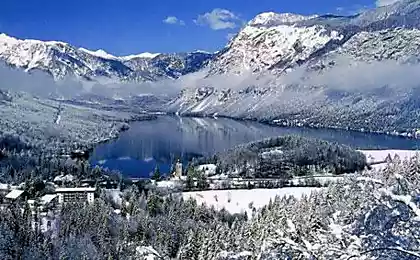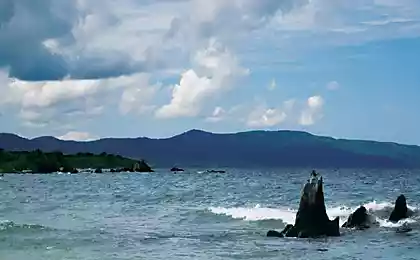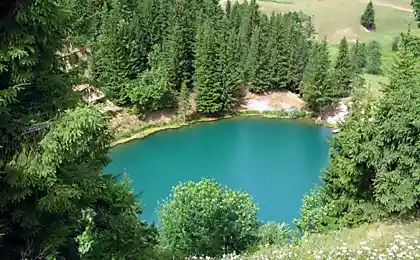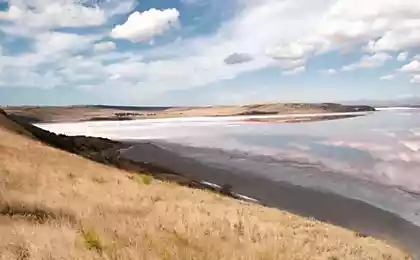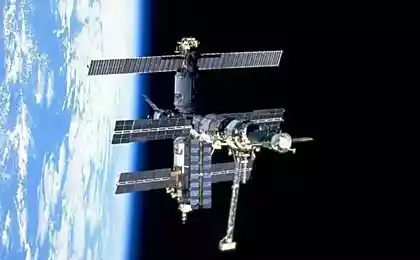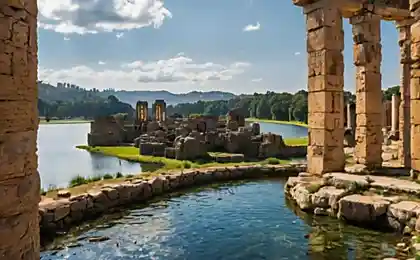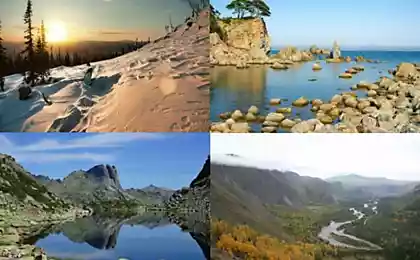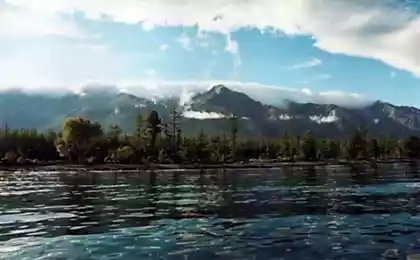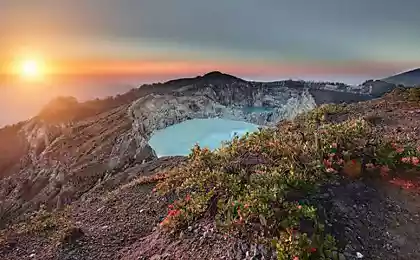740
The deepest lakes in the world
Imagine swimming in a deep lake and can't see its bottom. You just feel like frosting cold water the water depths that extends to infinity. Many people are afraid of depth, and even the best swimmer in the world can experience fear after stories about the legends and mysteries Shrouding the bottomless water of the deepest lakes in the world. The depth of any lake change due to climate and seasonal rains, but in General, there are certain flat rates. Today we explore ten of the deepest lakes in the world, learn about their history and secrets.
10. Lake Matano Lake Matano is of tectonic origin and is situated in South Sulawesi in Indonesia. This is an important freshwater resource in the region and the deepest lake of the country with a maximum depth of 590 meters. Lake Matano is well known for its extremely clear waters and a variety of local fish species. On its banks there are large reserves of Nickel ore.
9. Crater Lake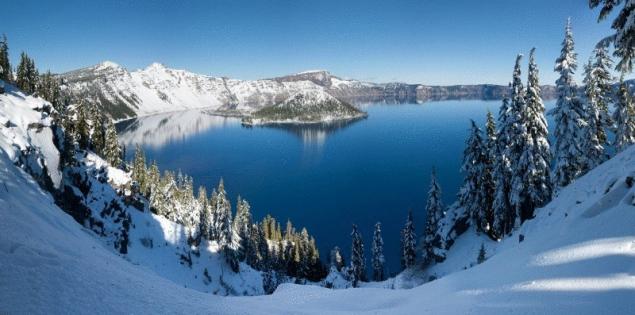
With striking volcanic past, crater lake is located in a National Park, and crater lake in Oregon. It is a place of immeasurable beauty, surrounded by cliffs 600 meters high, with two small Islands. Crater is a breathtaking open sea, a real laboratory for photographers. It is the deepest lake in the United States, with a maximum depth of 594 meters and with the cleanest water in North America (from the point of view of the absence of pollutants). The lake is fed by melting winter snow. Crater was formed 7,700 years ago after a violent eruption, but the legend can tell more. Indian tribe Klamath says about the outrageous war between Llao, spirit of the underworld, who lived in Mount Mazama and Scella — spirit of the upper world. Llao fell in love with Loha, daughter of the Indian chief Klamath, but was rejected and decided to punish the people with a curse of fire. Skelo came to help and after a long battle he managed to defeat Llao, whom he imprisoned deep in the Mountains of Mazama. In the end, he covered the pit of the great lake.
8. Great Slave lake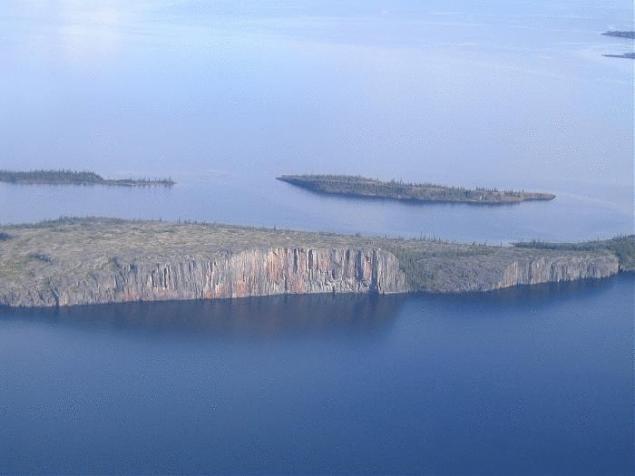
Great Slave lake covers an area of 11,000 square miles of the Northwest territories of Canada and reaches 615 m in depth, making it the deepest lake in North America. Due to the low temperatures in the region for eight months of the year, the lake is almost always partially frozen, while during winter the ice is so durable that it passing trucks and trailers. And although there is no physical evidence, it is rumoured that in the Great Slave lake lives an unidentified large creature. Many talk about the big hump in the water, usually taken over the rock, until he sinks back into the sea, or like an alligator monster with a pointed head. One Roman Catholic priest even saw a large creature with a dragon's head, which came out at the lake. The creature was later called, Slave.
7. Lake Issyk Kul
In the Republic of Kyrgyzstan in the Northern Tien Shan is lake Issyk-Kul — a lake of salt water, which 2,500 years ago was located in a very developed metropolis. The average water depth is 304 meters, while the deepest point is reduced to 668 meters. According to legend, during preislamic times, the king of the local ruler was the donkey ears. He managed to hide them, while killing all his barbers, so as not to reveal the secret. One day, one of the barbers escaped and revealed the secret, causing the water rose and flooded the Kingdom. Indeed, archaeological finds indicated the presence of an advanced ancient civilization in the place where currently is located the lake Issyk-Kul. This is one among the deepest lakes in the world.
6. Lake Malawi![]()
Also known as Lake Nyasa, Lake Malawi is the southernmost lake in the East African system the East African rift, located between Malawi, Mozambique and Tanzania. 706 meters deep, is the second deepest lake in Africa and its tropical waters it has more fish species than any other lake on Earth. The researchers studied soils sediments Lake Malawi and found that 100,000 years ago, the water level has decreased down to approximately the current level, turning the ground around the lake in semi-arid and arid habitat. According to some scholars, this may be the reason why early man ran away from Africa to other parts of the world.
5. Lake San Martin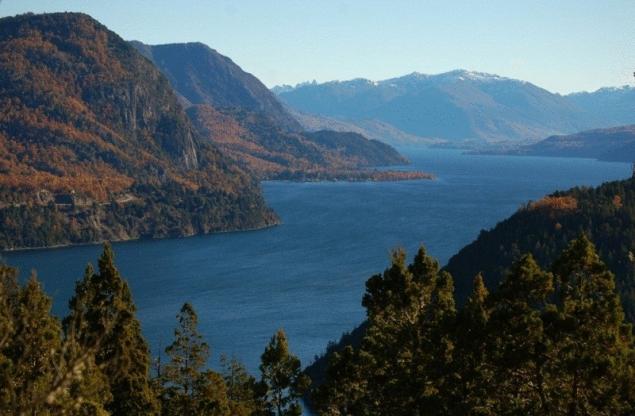
Located in Patagonia, the lake is called O'higgins in Chile and San martín in Argentina. It is the deepest lake in the Americas with a maximum depth of 835 meters (measurement of Glacier O'higgins). The lake is very irregular and consists of eight clearly defined sleeves with milky blue water, seeping through Kam'ianyste breed. The lake is named after South American heroes Jose de San Martin of Argentina and Bernardo O'higgins of Chile, who fought for the liberation of the country.
4. Lake Vostok
Of the 140 sub-glacial lakes on Earth, Vostok is the largest and deepest with a maximum depth of 899 metres. Located beneath the Russian station Vostok, at 3962 meters below the surface of the Central Antarctic ice sheet, is the most unexplored lake on Earth. British and Russian scientists have discovered it only in 1996. The average temperature of the water in lake Vostok is -3 °C. But despite freezing temperatures, the lake is in liquid state due to high pressure from the weight of ice.
The researchers also found that the ice core may be 420,000 more years. This means that the lake has closed more than 500,000 years ago. So far there is no evidence of life in Lake Vostok. Despite this, if the lake is living any variety, they will likely develop characteristics to survive in oxygen-rich environments of this deep lake.
3. The Caspian sea
Between the southern regions of the Russian Federation and Northern Iran is the largest enclosed body of water on Earth. The Caspian sea is a lake with salty water (salinity of approximately 1.2%), which has no outlet to the sea due to continental drift 5.5 million years ago. A remnant of the ancient Tethys ocean (exactly the same as Black, or Mediterranean), the Caspian sea is the third deepest lake in the world, with a depth of 1025 meters. Fauna in the Caspian basin is very rich: lots of sturgeons, Caspian white fish, Caspian roach, Caspian bream, and many rare species of salmon. The Caspian sea is very rich in energy resources, among which oil and gas deposits, discovered at the 10th century.
2. Tanganyika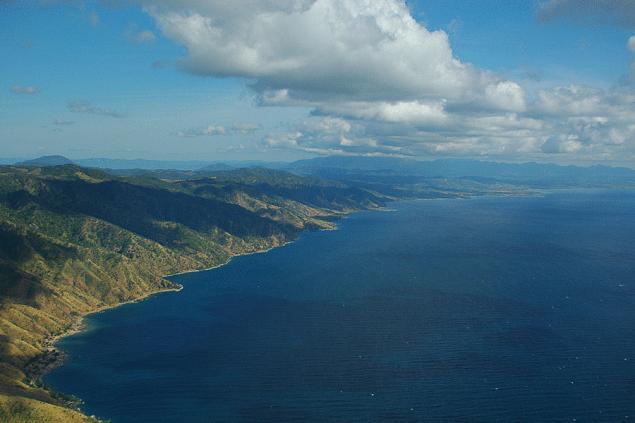
Divided between Burundi, the democratic Republic of the Congo (45%), Tanzania (41%) and Zambia, Tanganyika is the deepest freshwater lake in Africa and second deepest in the world with a maximum depth of 1470 meters. The lake was accidentally discovered in 1858 by two British explorers, Richard Burton and John Speke in their search for the source of the Nile. Run numerous stories about cold-blooded serial killer by the name of Gustav on the shores of Lake Tanganyika. It's a crocodile of 6 meters in length, which weighed 600 pounds and was responsible for the murder of hundreds of people.
1. The deepest lake — Baikal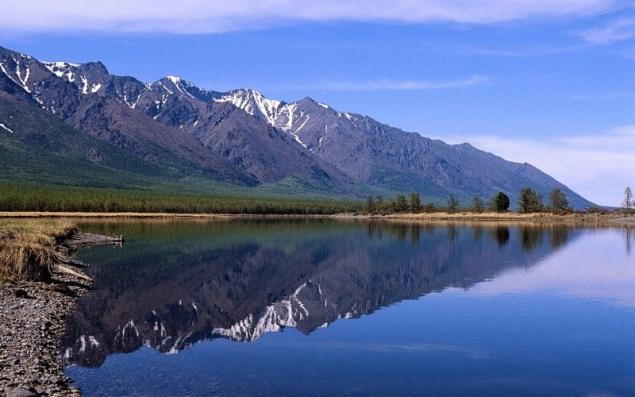
Also known as “blue eye of Siberia”, Lake Baikal is located in southern Siberia on the Russian-Mongolian border. Known as the deepest lake in the world with a maximum depth of 1636 meters, Baikal contains more water than all the Great lakes in General. Lake Baikal is a large ecosystem, with more than 1,700 species of flora and fauna, two thirds of which live only here. Completely surrounded by steep mountains and dense forests, the lake was formed approximately 25-30 million years ago, making it one of the most ancient lakes in geological history. This huge mass of water also has its own legend: a giant animal, its own Loch ness monster of lake Baikal. No one can say for certain is this story true, but the monster of lake Baikal exists in people's minds and haunts their thoughts.
Source: lifeglobe.net/
10. Lake Matano Lake Matano is of tectonic origin and is situated in South Sulawesi in Indonesia. This is an important freshwater resource in the region and the deepest lake of the country with a maximum depth of 590 meters. Lake Matano is well known for its extremely clear waters and a variety of local fish species. On its banks there are large reserves of Nickel ore.
9. Crater Lake

With striking volcanic past, crater lake is located in a National Park, and crater lake in Oregon. It is a place of immeasurable beauty, surrounded by cliffs 600 meters high, with two small Islands. Crater is a breathtaking open sea, a real laboratory for photographers. It is the deepest lake in the United States, with a maximum depth of 594 meters and with the cleanest water in North America (from the point of view of the absence of pollutants). The lake is fed by melting winter snow. Crater was formed 7,700 years ago after a violent eruption, but the legend can tell more. Indian tribe Klamath says about the outrageous war between Llao, spirit of the underworld, who lived in Mount Mazama and Scella — spirit of the upper world. Llao fell in love with Loha, daughter of the Indian chief Klamath, but was rejected and decided to punish the people with a curse of fire. Skelo came to help and after a long battle he managed to defeat Llao, whom he imprisoned deep in the Mountains of Mazama. In the end, he covered the pit of the great lake.
8. Great Slave lake

Great Slave lake covers an area of 11,000 square miles of the Northwest territories of Canada and reaches 615 m in depth, making it the deepest lake in North America. Due to the low temperatures in the region for eight months of the year, the lake is almost always partially frozen, while during winter the ice is so durable that it passing trucks and trailers. And although there is no physical evidence, it is rumoured that in the Great Slave lake lives an unidentified large creature. Many talk about the big hump in the water, usually taken over the rock, until he sinks back into the sea, or like an alligator monster with a pointed head. One Roman Catholic priest even saw a large creature with a dragon's head, which came out at the lake. The creature was later called, Slave.
7. Lake Issyk Kul

In the Republic of Kyrgyzstan in the Northern Tien Shan is lake Issyk-Kul — a lake of salt water, which 2,500 years ago was located in a very developed metropolis. The average water depth is 304 meters, while the deepest point is reduced to 668 meters. According to legend, during preislamic times, the king of the local ruler was the donkey ears. He managed to hide them, while killing all his barbers, so as not to reveal the secret. One day, one of the barbers escaped and revealed the secret, causing the water rose and flooded the Kingdom. Indeed, archaeological finds indicated the presence of an advanced ancient civilization in the place where currently is located the lake Issyk-Kul. This is one among the deepest lakes in the world.
6. Lake Malawi
Also known as Lake Nyasa, Lake Malawi is the southernmost lake in the East African system the East African rift, located between Malawi, Mozambique and Tanzania. 706 meters deep, is the second deepest lake in Africa and its tropical waters it has more fish species than any other lake on Earth. The researchers studied soils sediments Lake Malawi and found that 100,000 years ago, the water level has decreased down to approximately the current level, turning the ground around the lake in semi-arid and arid habitat. According to some scholars, this may be the reason why early man ran away from Africa to other parts of the world.
5. Lake San Martin

Located in Patagonia, the lake is called O'higgins in Chile and San martín in Argentina. It is the deepest lake in the Americas with a maximum depth of 835 meters (measurement of Glacier O'higgins). The lake is very irregular and consists of eight clearly defined sleeves with milky blue water, seeping through Kam'ianyste breed. The lake is named after South American heroes Jose de San Martin of Argentina and Bernardo O'higgins of Chile, who fought for the liberation of the country.
4. Lake Vostok

Of the 140 sub-glacial lakes on Earth, Vostok is the largest and deepest with a maximum depth of 899 metres. Located beneath the Russian station Vostok, at 3962 meters below the surface of the Central Antarctic ice sheet, is the most unexplored lake on Earth. British and Russian scientists have discovered it only in 1996. The average temperature of the water in lake Vostok is -3 °C. But despite freezing temperatures, the lake is in liquid state due to high pressure from the weight of ice.
The researchers also found that the ice core may be 420,000 more years. This means that the lake has closed more than 500,000 years ago. So far there is no evidence of life in Lake Vostok. Despite this, if the lake is living any variety, they will likely develop characteristics to survive in oxygen-rich environments of this deep lake.
3. The Caspian sea

Between the southern regions of the Russian Federation and Northern Iran is the largest enclosed body of water on Earth. The Caspian sea is a lake with salty water (salinity of approximately 1.2%), which has no outlet to the sea due to continental drift 5.5 million years ago. A remnant of the ancient Tethys ocean (exactly the same as Black, or Mediterranean), the Caspian sea is the third deepest lake in the world, with a depth of 1025 meters. Fauna in the Caspian basin is very rich: lots of sturgeons, Caspian white fish, Caspian roach, Caspian bream, and many rare species of salmon. The Caspian sea is very rich in energy resources, among which oil and gas deposits, discovered at the 10th century.
2. Tanganyika

Divided between Burundi, the democratic Republic of the Congo (45%), Tanzania (41%) and Zambia, Tanganyika is the deepest freshwater lake in Africa and second deepest in the world with a maximum depth of 1470 meters. The lake was accidentally discovered in 1858 by two British explorers, Richard Burton and John Speke in their search for the source of the Nile. Run numerous stories about cold-blooded serial killer by the name of Gustav on the shores of Lake Tanganyika. It's a crocodile of 6 meters in length, which weighed 600 pounds and was responsible for the murder of hundreds of people.
1. The deepest lake — Baikal

Also known as “blue eye of Siberia”, Lake Baikal is located in southern Siberia on the Russian-Mongolian border. Known as the deepest lake in the world with a maximum depth of 1636 meters, Baikal contains more water than all the Great lakes in General. Lake Baikal is a large ecosystem, with more than 1,700 species of flora and fauna, two thirds of which live only here. Completely surrounded by steep mountains and dense forests, the lake was formed approximately 25-30 million years ago, making it one of the most ancient lakes in geological history. This huge mass of water also has its own legend: a giant animal, its own Loch ness monster of lake Baikal. No one can say for certain is this story true, but the monster of lake Baikal exists in people's minds and haunts their thoughts.
Source: lifeglobe.net/

